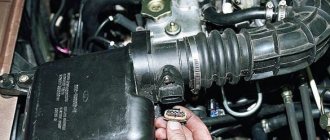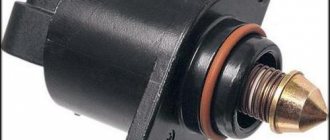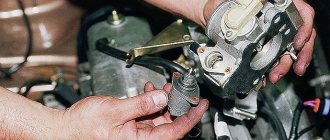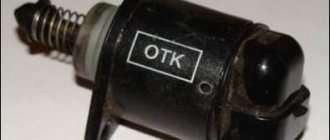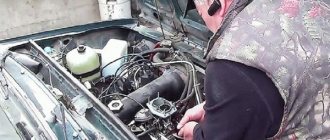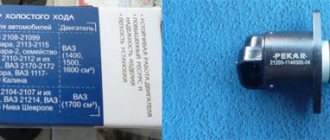You need to know how to set the idle speed of the VAZ 2106 in order to adjust the carburetor. You can perform this procedure quite quickly with your own hands, if, of course, you have an idea of what a carburetor consists of and the functions of its main components. But first things first, let's start with the saddest thing - the case when suddenly there is no idle speed and the engine starts to stall.
It doesn't matter where you are, at what point! It is important that the program for a small car service is always at hand! And wherever you are, information about business processes and spare parts sales is available. Live easier!
You'll be lucky if this happens close to home. But if you’re on the road, it’s not good enough. On my own behalf, I’ll add that several times I had to remove and disassemble the carburetor while standing on a narrow highway, shying away from passing trucks and highlighting it with a flashlight. A good habit is to take a thermos and a flashlight on the road.
Device
At the initial stage of development of injection engines, rotor and solenoid devices were used as idle speed regulators. They could have two operating positions - here we can draw an analogy with a shut-off valve. The sensor operated in the fully open or fully closed position. This did not allow the idle speed to be effectively stabilized.
Subsequently, AvtoVAZ engineers created an idle speed sensor for the VAZ-2109 injector in the form of a stepper valve. It is distinguished by the presence of stepwise adjustment of the air supply through a bypass channel in the throttle valve.
The IAC is designed as follows: it is based on a small stepper motor, and the device also contains a rod, a spring and a needle.
Functions
The IAC regulates the amount of air entering the engine when the throttle valve is closed. This suggests that the IAC performs the functions of automatically adjusting the specified engine speed when idling.
The regulator also takes part in the process of warming up the engine to optimal operating temperatures in winter. The operating temperature range of the IAC is quite wide - from -40 to +130 degrees Celsius.
The IAC, despite such important functions, is small in size and consists of three main elements:
- Stepper electric motor;
- Spring;
- A rod with a cone-shaped needle at the end.
The idle speed control is mounted on the throttle body with a pair of screws.
IAC location
Operating principle
When the car is moving and the throttle valve is open, the IAC is not involved in the process, its valve is closed and the rod is motionless. When the damper closes and the engine goes into idle mode, voltage is applied to the electric motor and the rod moves towards the opening - the valve comes into operation. It opens slightly, and air enters the engine bypassing through a special hole.
When the driver turns on the ignition, the IAC rod fully extends to its extreme position and closes the calibration hole in the throttle pipe. The sensor then counts the steps and the valve returns to its home position. As for this basic position, it can be different and depends on the firmware installed in the ECU. For January 5.1 firmware the position is 120 steps, for Bosch firmware it is 50 steps.
Principle of operation
It is not entirely correct to call the idle speed sensor a sensor. After all, they are measuring instruments that process and convert information, displaying it on mechanical or electronic indicators on the dashboard.
Alas, the self-diagnosis systems on the VAZ 2109 are not perfect, therefore, if the idle air regulator fails, the car does not notify you about it even by turning on the Check Engine warning light. Therefore, you have to navigate by signs of breakdown.
The IAC works as follows. When the ignition switch is turned on, the rod on the sensor extends all the way and rests against a special hole in the throttle pipe. The IAC begins to read the steps and the valve returns to its original position. When the engine is running, increasing or decreasing the number of steps causes a change in the volume of air entering through the hole. Consequently, the required amount of air flows into the engine, ensuring stable operation of the engine at idle.
DXX connection diagram
The idle air control is connected with a single four-wire cable. The wire of the VAZ-2109 idle speed sensor is connected to the ECU. Such wiring creates certain problems when trying to diagnose the sensor yourself. You won’t be able to simply apply voltage to the terminal for testing: the ECU supplies voltage to the windings of the stepper motor in pulse mode. Therefore, checking with a multimeter in case of a malfunction is not very effective.
Symptoms of a problem
This element is responsible for the operation of the engine at idle, which means that any malfunction will affect the stability of the idle speed. Among the main symptoms of HPP failure are:
- unstable idle;
- drop in crankshaft speed when additional electrical consumers are turned on;
- absence of increased warm-up speeds during cold starts of the power unit;
- stopping the internal combustion engine when turning off or changing gear.
These symptoms will not always be the cause of a malfunction of the VAZ-2109 idle speed sensor (injector), since the same symptoms will occur if the TPS fails. But if there is a problem with the throttle position sensor, the check engine light will come on. Since the IAC, or idle speed sensor, does not have its own diagnostic system, the lamp will not light up with the same symptoms.
Location
Knowing the principle of operation of the VAZ-2109 idle speed sensor (injector), it is not difficult to guess where it should be installed. On this vehicle it is located near the throttle valve and throttle position sensor. The device is fixed with screws on the damper body. In case of failure, the car owner can easily replace it himself.
The simplest diagnosis of DXX
The easiest way to check the idle speed sensor of the VAZ-2109 is the following method. Need a friend's help. The sensor is disconnected from the connector, then the mounting screws are unscrewed and the device is dismantled. Next, the regulator will be plugged into the connector again, but held in your hands.
At this time, the assistant starts the power unit, and the IAC rod should at this moment retract completely and then extend to a certain distance. If the device behaves this way, then it is operational - the rod is not bent, it is not jammed inside the valve. But there is no guarantee that the device matches the ECU firmware. The rod extends, but the number of steps is unknown. There is a marking on the connector - you can use it to ensure that the ECU sensor matches.
This is the initial stage of diagnosis. Next, check the electrical part, the condition of the valve, and the degree of needle wear.
How to check a sensor with a multimeter
Using a multimeter, you can diagnose the VAZ-2109 idle speed sensor (injector) in two ways: first, measure in ohmmeter mode, then in voltmeter mode.
If you close the contacts on the CD and AB plugs, the multimeter should show a resistance in the range of 40-80 Ohms. If you close the DC and AD contacts with probes, then the multimeter on a working IAC will show infinity.
In voltmeter mode, the voltage on the sensor when the ignition is on should be 12-20 V.
Diagnostics on the stand
The simplest stands for checking IAC will cost the average car enthusiast 1,500-2,000 rubles. Replacing the idle speed sensor on a VAZ-2109 will cost 300 rubles. Therefore, purchasing a stand is not economically feasible. You can assemble a simple stand with your own hands. The circuit consists of a charger from any mobile equipment with a voltage of 6 V, a plug block and a test lamp. If the lamp lights up during the test, then the IAC is faulty. If the lamp burns at half intensity, then the device is working properly.
How to replace the idle speed sensor
If cleaning does not help and the IAC does not work, then the VAZ-2109 idle speed sensor (injector) needs to be replaced. This is done very simply.
The sensor is installed on the throttle body. It is secured with two screws, just like the fuel pump. To remove, unscrew the mounting bolts and disconnect the plug from the device. Before installing a new DXH, it is recommended to sand the seat.
The new IAC is installed in the same way, in reverse order. The element is installed in place, fixed with bolts, and wires are connected. But sometimes it happens that replacement does not solve the problem, and the idle speed fluctuates even with a new sensor. The reason here is the quality of spare parts in stores - before installation, it is better to make sure that the new sensor is working.
Replacement or cleaning
Practice shows that in a fairly large number of cases, simply cleaning the idle air regulator allows you to restore its functionality. Therefore, we advise you to try this method first. And if it does not give results, then it will not be difficult to replace the device.
- Buy a container of carburetor cleaner. In this case, your engine may well be fuel-injected. It’s just that this composition is excellent for cleaning IACs and more.
- Disconnect the connector with wires from the sensor, unscrew the two fasteners and remove the affected regulator itself.
- Clean the regulator from accumulated debris and contaminants, and be sure to clean the needle and spring itself. This should be done with carburetor cleaner. Use available tools to tidy up a fairly compact device.
- Be sure to clean the idle air control housing on the throttle assembly. This is where the cone-shaped needle of the XX sensor enters.
- After completing the cleaning of the device, return it to its place and check its operation.
- If cleaning does not bring the desired result, the engine continues to behave inadequately, you will have to purchase a new regulator and install it in place of the old sensor.
- Before replacing, be sure to turn off the power to the car by disconnecting the negative terminal from the battery, then disconnect the block with the power wires, unscrew the mounting screws and remove the device.
- Reassemble in reverse order.
Disassembling the unit for cleaning or replacement
The main thing here is to act carefully and not to overdo it with the carburetor cleaner if you first decide to try cleaning the device. Otherwise, replacing the IAC does not cause problems even for beginners.
Injection cars use a power system that is different from the carburetor with its channel for idling the engine. To support engine operation in idle mode, the VAZ-2109 injector idle speed sensor is used. Experts call it differently: XX sensor or XX regulator. This device practically does not cause problems for the car owner, but sometimes it still fails.
Replacing the idle speed sensor on a VAZ 2109 injector yourself
As you know, replacing the idle speed sensor on a VAZ 2109 injector can be done with your own hands. This is not difficult to do. Replacing the idle speed sensor on a VAZ 2109 is a mandatory process, since imagining a car that does not have an idle speed is simply ridiculous. If you drive such a car in a city where there is a traffic light every half kilometer, it will be, to put it mildly, not comfortable. A car's idle speed sensor is as important a part as a fuel pump, carburetor or any other part.
Lada 2109 1992, 71 l. With. — self-repair
Comments 6
Participate in the discussion can only registered users.
All this is in vain, you just had to replace the xx system if it failed, but most likely just clean and adjust the carb YOURSELF.
Kalkhoz is not Kalkhoz, I don’t know, but I still have problems in my car and there is no point in solving this every time... regarding setting up the carb, I go to carburetor specialists and I don’t know how to set it up.
In my opinion, this is a collective farm solution to this problem. The carburetor needs to be adjusted. Have you tried turning the quality screw, it also affects xx. Maybe you even have a buggy system epkhh.
I suffered for a long time with magnetic valves (I changed 4 pieces) In the end I bought an expensive one (170 rubles) - as they said, “factory”)) Pah-pah it works for now, but when it “cracks” I’ll probably do the same as you. I won’t buy another valve) )
Yes) bite the needle off the old one and there will be no problems)
Source
How does he work
The vehicle idle speed sensor performs a number of specific functions that are very important. If this part does not work well or fails, then it may be impossible not to turn off the car when you need to stop, for example, at a traffic light. Driving a car with a faulty idle speed sensor is not only uncomfortable, but also very dangerous. As soon as it is noticed that there is a problem with a given part, it may need to be repaired or replaced. The idle speed sensor is also called a regulator. On models such as the VAZ 2114 or other modifications of the Samara, this idle speed regulator is designed to stabilize idle speed. On the VAZ 2109 it performs a more complex function. The sensor is a small electric motor equipped with a conical needle.
Removed idle speed sensor
This part is located in cars of the VAZ family on the throttle body, next to the damper. The idle speed sensor itself, which we will call IAC, is attached here with two screws. But it also happens that dismantling this element sometimes causes difficulties. And all this is due to the fact that in addition to fixing with screws, the DXX is mounted on varnish. Let's look at what happens when the ignition is turned on:
- At this moment, the rod located on the idle speed control moves completely forward, resting against a special calibration hole located in the throttle pipe.
- After this, the sensor begins to work. He counts the steps and returns the valve back. And the position of this very valve depends on the time of year and engine warm-up. For example, this could be equal to 50 steps with the motor running.
- As the steps increase or decrease, the air passing through the calibration hole is under constant change. When the rod is extended, the steps increase. The reverse process occurs when the rod returns to its original position. The stroke of the rod itself on the vase is approximately 250 steps.
- The idle speed is controlled by a sensor that is assisted by air. In other words, air entering the engine regulates idle speed.
- The mass flow sensor analyzes the incoming air based on its quantity. As for the controller, it supplies the required amount of gasoline or other fuel directly to the engine through the fuel injectors. Thus, the process of supplying the required volume of air occurs.
- As for a cold engine, the controller in this case increases the speed only due to the presence of the DXX. And this mode allows you to move away even without necessarily warming up the engine.
Setting the float chamber level
This is the first step in adjusting any carburetor. It is on this part that the consumption and stability of the engine will depend. The level must be at the nominal level set by the manufacturer, so it is very important to follow the technology.
Setting the fuel level in the float chamber: I - carburetor cover; 2 — needle valve seat; 3 - emphasis; 4 - needle valve; 5 - locking needle ball; 6 - valve needle pull-out fork; 7 — float bracket; 8 - tongue; 9 — float; 10 - gasket.
The top cover of the carburetor is removed, but before that, you need to pump up the manual fuel pump to check the set level. The nominal level is the level of gasoline located on half of the inclined surface. If it is higher or lower, then adjust the float level by bending the adjusting antennae. The XX speed is also regulated by the float chamber.
To check, just put the cover on top, start the engine and immediately turn it off. Open the lid again and check the level. After this, you can move on to the next stage.
How to find out if the sensor is faulty
This is not so difficult to do, although the regulator is not equipped with a self-diagnosis system, when the results are sent to the on-board computer or a light-up panel device. Here are the main signs of a faulty DX:
- the car stalls at idle;
- There are absolutely no increased speeds on a cold engine;
- idle speed fluctuates;
- The car stalls when you try to change gear at the gearbox.
How to check the idle speed sensor yourself
To be completely sure that the cause of the above defects is the DX, you should check it. If the reason is the regulator, then it will need to be replaced, especially since it is not that expensive.
